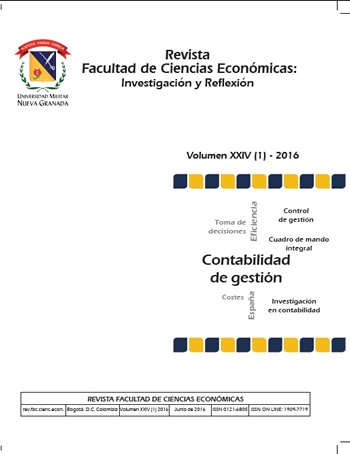The implementation of the balanced scorecard in the agri-food sector : the case of food group guissona
Abstract
The Guissona Food Group (located in the province of Lleida in Spain), was born with a strategic vision that has led it to position itself with remarkable success in the market. It has also implemented several management tools that have enabled the company to develop, adapt and grow for more than 50 years. This article discusses the implementation of a Balanced Scorecard (BSC) to monitor the aforementioned strategy. It is suggested to implement this particular tool, since it is the fifth most used management tool in the world according to the biannual study conducted by Bain & Company (Rigby & Bilodeau, 2013). BSC's proposal contained in this study includes 27 indicators, ranked the 4 perspectives proposed in the BSC.Downloads
References
Amat, O., Campa-Planas, F. & Fernández, A. (2013) “Cuadro de Mando Integral” En: Amat, O. & Campa-Planas, F. (Coord.). Manual del Controller. Asociación Catalana de Contabilidad y Dirección. Barcelona: Profit Editorial.
Aparisi Caudeli, J. A. (2008). La eficacia del Cuadro de Mando Integral en el control estratégico de las entidades públicas. Valencia: Sindicatura de Comptes.
Banchieri, L.C. & Campa-Planas, F. (2010). “La utilización del Cuadro de Mando Integral en Cataluña”. VI Congreso Iberoamericano de Administración Empresarial y Contabilidad y IV Congreso Iberoamericano de Contabilidad de Gestión. Valencia, 7-9 de Junio de 2010.
Banchieri, L.C., Campa-Planas, F. & Sánchez-Rebull, M.V. (2011) “What has been said, and what remains to be said, about the Balanced Scorecard?”. En Proceedings of Rijeka Faculty of Economics Journal of Economics and Business, 29 (1): 155-192.
Brignall, T.J. (2002) “The unbalanced scorecard: a social and environmental critique”. En: Performance Measurement and Management (2002): research and action: papers from the Third: 85-92.
De Geuser, F., Mooraj, S. & Oyon, D. (2009) “Does the Balanced Scorecard Add Value? Empirical Evidence on its Effect on Performance”. En European Accounting Review, 18 (1): 93-122.
Epstein, M. & Manzoni, J. (1998) “Implementing corporate strategy: From tableaux de Bord to Balanced Scorecard”. En: European Management Journal, 16 (2): 190-203.
Figge, F., Hahn, T., Schaltegger, S. & Wargner, M. (2002) “The sustainability balanced scorecard - linking sustainability management to business strategy”. En Business Strategy and the Environment, (11): 269-284.
Grau, A. & Sole, M. F. (2013) “La retribución variable” En: Amat, O. y Campa-Planas F. (Coord.). Manual del Controller. Asociación Catalana de Contabilidad y Dirección. Barcelona: Profit Editorial.
Kaplan, R. S. & Norton, D. P. (1992) “The Balanced Scorecard-Measures That Drive Performance”. En: Harvard Business Review, 70 (1): 71-79.
Kaplan, R. S. & Norton, D. P. (1993) “Putting the Balanced Scorecard to Work”. En Harvard Business Review, 71 (5): 134-147.
Kaplan, R. S. & Norton, D.P. (1996). The Balanced Scorecard: Translating strategy into action. Boston Massachusetts: Harvard Business School Press.
Lawrie, G. & Cobbold, I. (2004) “Third-generation balanced scorecard: evolution of an effective strategic control tool”. En: International Journal of Productivity and Performance Management, 53 (7): 611-623.
Leung, L. C., Lam, K. C. & Cao, D. (2006) “Implementing the balanced scorecard using the analytic hierarchy process & the analytic network process”. En: Journal of the Operational Research Society, 57 (6): 682-691.
Mooraj, S., Oyon, D. & Hostettler, D. (1999) “The Balanced Scorecard: a Necessary Good or an Unnecessary Evil?” En: European Management Journal, 17 (5): 481.
Nørreklit, H. (2000) “The balance on the balanced scorecard—a critical analysis of some of its assumptions”. En: Management Accounting Research, 11 (1): 65-88.
Porporato, M. & Parkinson, J. (2008) “Una investigación empírica sobre los factores que afectan a la selección de medidas del Cuadro de Mando Integral”. En: Revista Iberoamericana de Contabilidad de Gestión, 6 (12).
Quilivan, D. (2000) “Rescaling the Balanced Scorecard for Local Government”. En: Australian Journal of Public Administration, 59 (4): 36-41.
Rigby, D. & Bilodeau, B. (2013) “Management Tools and Trends 2013”. Disponible en: http://www.bain.com/Images/BAIN_BRIEF_Management_Tools_%26_Trends_2013.pdf [consultado 7 de Noviembre de 2014].
Van Der Woerd, F. & Van Den Brink, T. (2004) “Feasibility of a Responsive Business Scorecard--a pilot study”. En: Journal of Business Ethics, 55 (2): 173-186.











